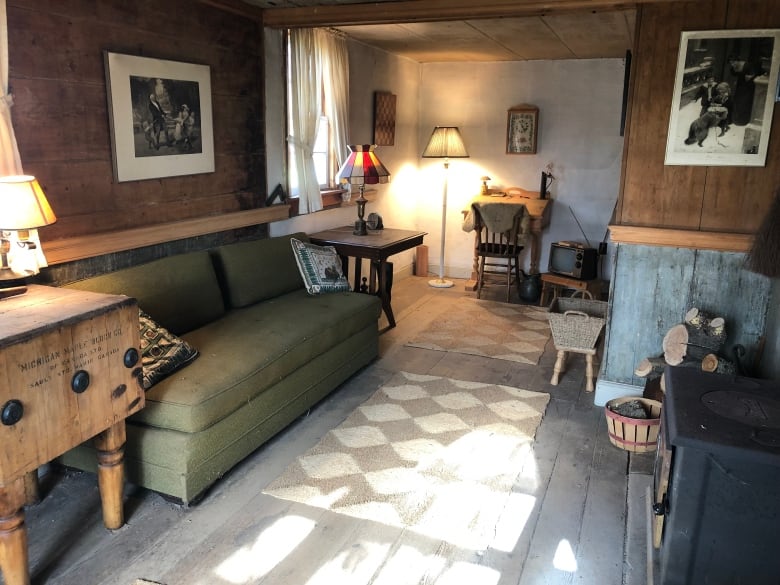Robert McGregor showed hundreds of houses in his career as a real estate agent, but none quite like the little old house in Belmont, N.S.
And it’s not for sale; it’s almost never for sale.
The humble grey house set amid rolling farmland near Windsor dates back to the Planters, the New Englanders who immigrated to Nova Scotia in the 1750s and 1760s.
The old house on Belmont Road became the new home for the Church family some time in the 1700s, and it remained known as the Church Farm and occupied by a Church up into the 1970s.
It’s built of birch and pine, likely hewn by the same hands that first called it home. McGregor’s parents, James and Jane, bought the house on a whim in 1971. His father was an immigrant, too, having moved from northern Scotland to Nova Scotia.

James McGregor was on a business trip to a Windsor pharmacy when the elderly pharmacist surprised him by asking if he was interested in buying a farm.
“And my father wasn’t at the time,” his son says.
But something about the old man’s description of the house intrigued him and he drove out to visit. It reminded him of a traditional Scottish croft and he bought it. It came with one unusual closing condition: the last Church, Dexter Church, could live in the house for the rest of his life.
The McGregors agreed and began parking a camper on the property for the first few summers.
McGregor says Dexter Church half-hoped the house would fall down on him and dismissed his parents’ renovation efforts as putting “rags upon rags.”

McGregor says the words became a family mantra. In fact, his parents were more interested in removing some of the “rags.”
“When my parents got the property, there were layers, layers, layers of wallpaper on here, which they were able to remove by steaming and chemicals and eventually got down to what’s called an ochre paint, where you can see the red, which is basically the clay that’s in the river,” he explains, holding a chunk of some of the dozen or so layers they removed to get down to the original wood.
They dug through about 18 layers of linoleum and other faux floors to get to the original wood. They modernized it a bit, adding an indoor toilet.

“When my father was working on the outhouse, taking down a wall, he found this document between the boards,” McGregor says, showing a now-framed letter from former prime minister John Diefenbaker to Dexter Church, thanking him for a poem.
When Church died, McGregor’s family made it their other forever home, a place for school summers, a retreat from working life, and in later years, a retirement home in the renovated barn.

McGregor’s parents both died in 2019. That made their cottage even more special to him, and in his own retirement he’s building a solid foundation for future generations on Church Farm.
One foundation wall started to collapse this year, but with a little help he had the stone wall rebuilt and added a thick gravel floor to keep the wet away. He says the basement is actually his favourite part of the house; as a boy, he spent hours down there, digging in the dirt for centuries of buried treasure.

His boyhood bottle cap collection is still in his upstairs bedroom, as is a handmade kite created in the distant past.
His other favourite place is the hearth, and he puts another log on the fire to get a blazing warmth.
“This is where people back then would have cooked, warmed themselves, sat and discussed things. This would have been the heart of the house,” he says.
He points out the odd hinges on the closet door next to the hearth.
“That’s what’s known as an H-L hinge, which stands for Holy Lord, and that’s to keep the devil out of the closet.”

Now, he likes to sit by the fire, contemplating what life was like for the generations of families on Church Farm. Births, lives and deaths, all lived out under the old roof. The farm provided what was needed.
He wants to register the house as a historic property.
“But the next big ticket item will be the roof. I’m not going to go asphalt shingles, or metal roof; I’m going to go back with cedar shakes, as that’s what the home would have had originally.”
He never saw another house like his in the 20-plus years he spent in real estate all over Nova Scotia. Most people are drawn to brand-new homes, or “old” ones from the 1970s; few people seek an original home from the 1700s.
But though he and his wife have a home in Halifax, there’s no place like the home in Belmont. Even now, as he spends more time here with memories than with people, he never feels alone.
“We never really noticed anything, but a number of people over the years when coming in the door say they feel a presence. They felt there was a spirit — a friendly one — that went with the property.”
He’s keeping that friendly spirit alive in the old house and hopes one day to turn it into a museum, so new generations can sit by the fire and contemplate what it means to call a place home.

MORE TOP STORIES





More Stories
Fair share: the right office solution can take finding the right partner
Ontario faces crew shortages, aircraft issues in fight against wildfires | Globalnews.ca
Refugee attends open house at Downtown Eastside affordable housing facility – BC | Globalnews.ca